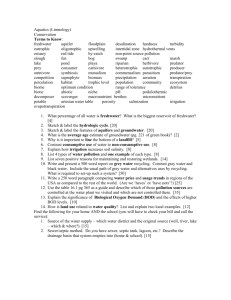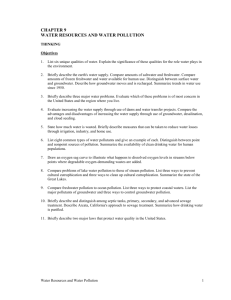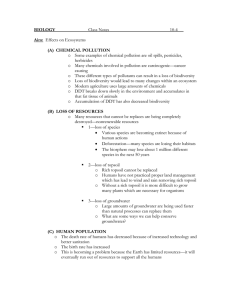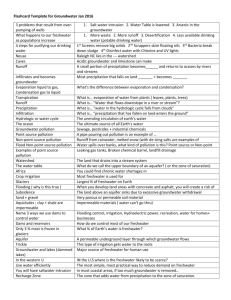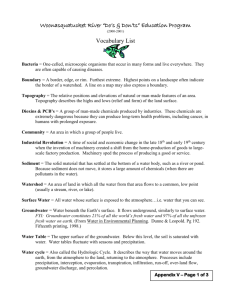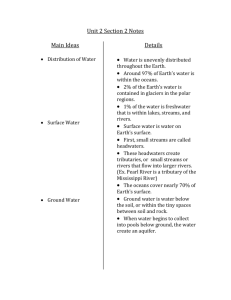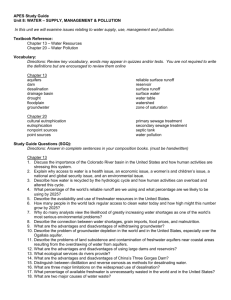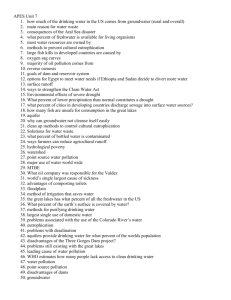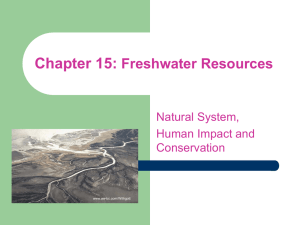Study Guide 1
advertisement
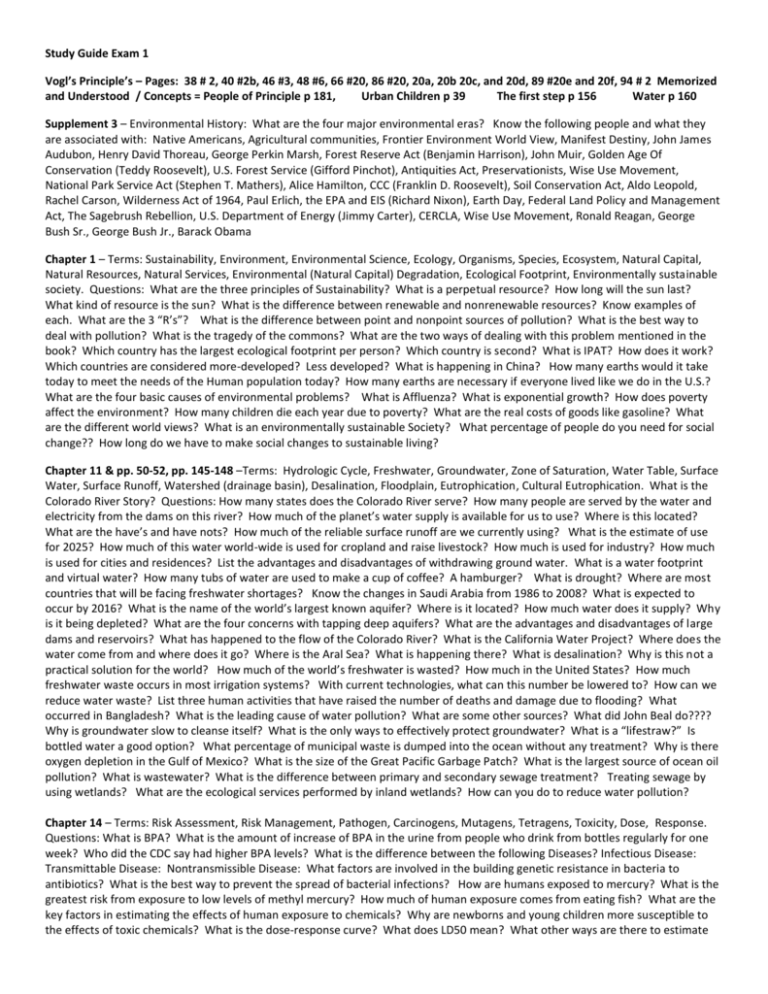
Study Guide Exam 1 Vogl’s Principle’s – Pages: 38 # 2, 40 #2b, 46 #3, 48 #6, 66 #20, 86 #20, 20a, 20b 20c, and 20d, 89 #20e and 20f, 94 # 2 Memorized and Understood / Concepts = People of Principle p 181, Urban Children p 39 The first step p 156 Water p 160 Supplement 3 – Environmental History: What are the four major environmental eras? Know the following people and what they are associated with: Native Americans, Agricultural communities, Frontier Environment World View, Manifest Destiny, John James Audubon, Henry David Thoreau, George Perkin Marsh, Forest Reserve Act (Benjamin Harrison), John Muir, Golden Age Of Conservation (Teddy Roosevelt), U.S. Forest Service (Gifford Pinchot), Antiquities Act, Preservationists, Wise Use Movement, National Park Service Act (Stephen T. Mathers), Alice Hamilton, CCC (Franklin D. Roosevelt), Soil Conservation Act, Aldo Leopold, Rachel Carson, Wilderness Act of 1964, Paul Erlich, the EPA and EIS (Richard Nixon), Earth Day, Federal Land Policy and Management Act, The Sagebrush Rebellion, U.S. Department of Energy (Jimmy Carter), CERCLA, Wise Use Movement, Ronald Reagan, George Bush Sr., George Bush Jr., Barack Obama Chapter 1 – Terms: Sustainability, Environment, Environmental Science, Ecology, Organisms, Species, Ecosystem, Natural Capital, Natural Resources, Natural Services, Environmental (Natural Capital) Degradation, Ecological Footprint, Environmentally sustainable society. Questions: What are the three principles of Sustainability? What is a perpetual resource? How long will the sun last? What kind of resource is the sun? What is the difference between renewable and nonrenewable resources? Know examples of each. What are the 3 “R’s”? What is the difference between point and nonpoint sources of pollution? What is the best way to deal with pollution? What is the tragedy of the commons? What are the two ways of dealing with this problem mentioned in the book? Which country has the largest ecological footprint per person? Which country is second? What is IPAT? How does it work? Which countries are considered more-developed? Less developed? What is happening in China? How many earths would it take today to meet the needs of the Human population today? How many earths are necessary if everyone lived like we do in the U.S.? What are the four basic causes of environmental problems? What is Affluenza? What is exponential growth? How does poverty affect the environment? How many children die each year due to poverty? What are the real costs of goods like gasoline? What are the different world views? What is an environmentally sustainable Society? What percentage of people do you need for social change?? How long do we have to make social changes to sustainable living? Chapter 11 & pp. 50-52, pp. 145-148 –Terms: Hydrologic Cycle, Freshwater, Groundwater, Zone of Saturation, Water Table, Surface Water, Surface Runoff, Watershed (drainage basin), Desalination, Floodplain, Eutrophication, Cultural Eutrophication. What is the Colorado River Story? Questions: How many states does the Colorado River serve? How many people are served by the water and electricity from the dams on this river? How much of the planet’s water supply is available for us to use? Where is this located? What are the have’s and have nots? How much of the reliable surface runoff are we currently using? What is the estimate of use for 2025? How much of this water world-wide is used for cropland and raise livestock? How much is used for industry? How much is used for cities and residences? List the advantages and disadvantages of withdrawing ground water. What is a water footprint and virtual water? How many tubs of water are used to make a cup of coffee? A hamburger? What is drought? Where are most countries that will be facing freshwater shortages? Know the changes in Saudi Arabia from 1986 to 2008? What is expected to occur by 2016? What is the name of the world’s largest known aquifer? Where is it located? How much water does it supply? Why is it being depleted? What are the four concerns with tapping deep aquifers? What are the advantages and disadvantages of large dams and reservoirs? What has happened to the flow of the Colorado River? What is the California Water Project? Where does the water come from and where does it go? Where is the Aral Sea? What is happening there? What is desalination? Why is this not a practical solution for the world? How much of the world’s freshwater is wasted? How much in the United States? How much freshwater waste occurs in most irrigation systems? With current technologies, what can this number be lowered to? How can we reduce water waste? List three human activities that have raised the number of deaths and damage due to flooding? What occurred in Bangladesh? What is the leading cause of water pollution? What are some other sources? What did John Beal do???? Why is groundwater slow to cleanse itself? What is the only ways to effectively protect groundwater? What is a “lifestraw?” Is bottled water a good option? What percentage of municipal waste is dumped into the ocean without any treatment? Why is there oxygen depletion in the Gulf of Mexico? What is the size of the Great Pacific Garbage Patch? What is the largest source of ocean oil pollution? What is wastewater? What is the difference between primary and secondary sewage treatment? Treating sewage by using wetlands? What are the ecological services performed by inland wetlands? How can you do to reduce water pollution? Chapter 14 – Terms: Risk Assessment, Risk Management, Pathogen, Carcinogens, Mutagens, Tetragens, Toxicity, Dose, Response. Questions: What is BPA? What is the amount of increase of BPA in the urine from people who drink from bottles regularly for one week? Who did the CDC say had higher BPA levels? What is the difference between the following Diseases? Infectious Disease: Transmittable Disease: Nontransmissible Disease: What factors are involved in the building genetic resistance in bacteria to antibiotics? What is the best way to prevent the spread of bacterial infections? How are humans exposed to mercury? What is the greatest risk from exposure to low levels of methyl mercury? How much of human exposure comes from eating fish? What are the key factors in estimating the effects of human exposure to chemicals? Why are newborns and young children more susceptible to the effects of toxic chemicals? What is the dose-response curve? What does LD50 mean? What other ways are there to estimate the harmful effect of chemicals? What is the estimate by the U.S. National Academy of Sciences of how many of the 80,000 registered synthetic chemicals have been thoroughly screened? What percentage of commercially available chemicals in the U.S are not supervised while in use? What do the greatest health risks come from? Study the two charts on pages 366-367. What are the five factors that cause people to poorly judge risks? What are the four guidelines for evaluating and reducing risk? Know the notes from the movies shown Tapped Strange Days on Planet Earth – Troubled Waters
